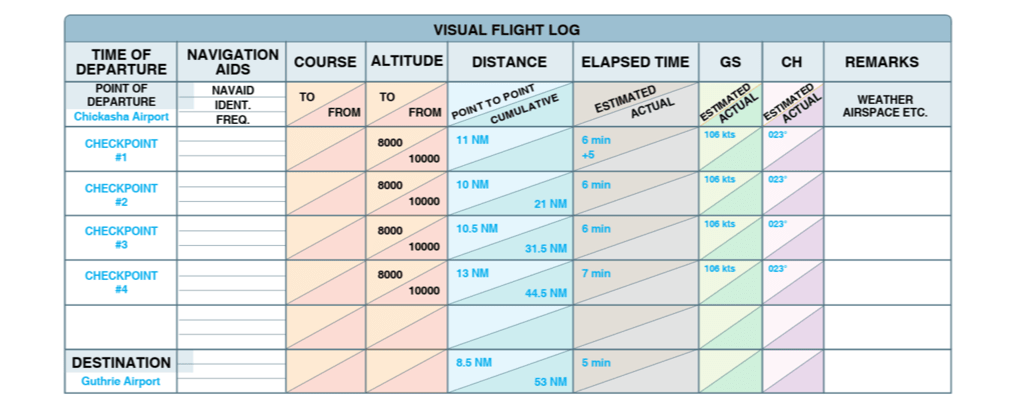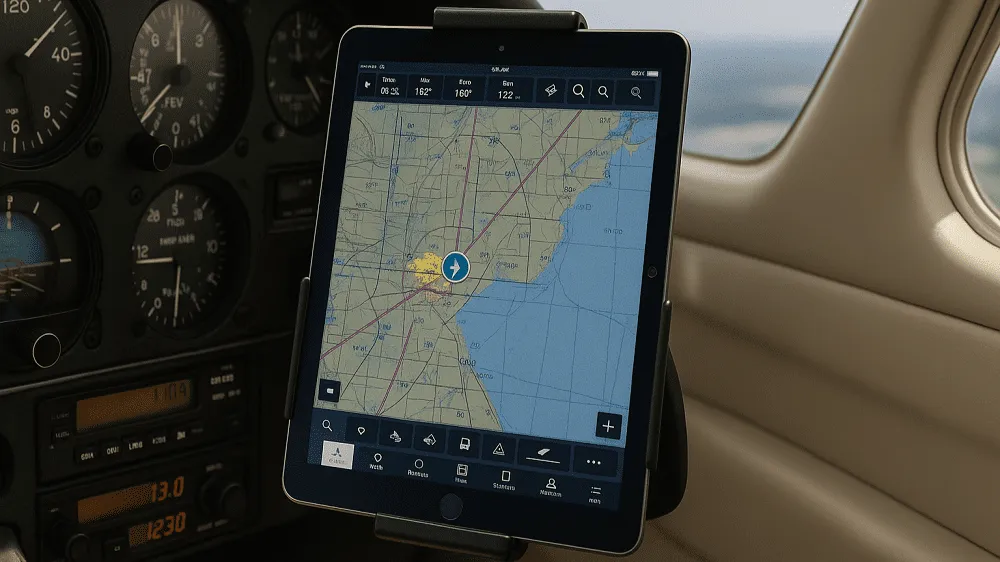Aviation Navigation Log Fundamentals That Matter
Understanding navigation logs is essential for safe and efficient flight planning. These logs are more than just paperwork; they’re crucial tools that help pilots organize vital information, anticipate potential challenges, and make informed decisions in the air. This systematic approach to flight planning is what separates effective logs from mere documentation exercises. Experienced pilots often emphasize the organizational value of navigation logs, highlighting how a well-structured log significantly improves situational awareness.
A key aspect that sets apart effective navigation logs is how they handle the regulatory framework. Instead of being weighed down by bureaucratic details, a good navigation log focuses on practical compliance. This means presenting information in a way that makes it easier for pilots to understand the regulations and how they apply to the planned flight. For instance, clearly marking airspace boundaries and altitudes directly on the log helps pilots quickly visualize and adhere to airspace restrictions.
Incorporating fuel planning directly into the log ensures compliance with fuel reserve requirements, a critical safety factor. A well-designed log streamlines the process, making it easier for pilots to access and interpret critical information during flight.
Furthermore, statistical data highlights the vital role of navigation logs in aviation safety. According to the FAA, navigation logs are essential for pilots to plan and execute flights safely by centralizing important information. The FAA stresses the importance of accurate flight planning and navigation for accident prevention. Navigation errors have been a factor in aviation accidents, underlining the need for precise navigation logs to mitigate such risks. Using navigation logs helps maintain compliance with aviation regulations, which is essential for safe flight operations.
Learn more in the FAA Pilot’s Handbook of Aeronautical Knowledge – Chapter 16.
Key Components of a Navigation Log
Beyond the basic requirements, a well-crafted navigation log incorporates several key elements:
Clear and concise route information: This includes departure and destination airports, waypoints, and planned altitudes.
Accurate time estimates: Calculating Estimated Times of Arrival (ETAs) for each waypoint helps maintain schedule adherence and efficient fuel management.
Detailed fuel planning: This involves calculating fuel consumption, reserves, and identifying potential fuel stops.
Contingency planning: A robust navigation log always includes alternate airports and procedures for unexpected situations.
Weather information: Integrating current and forecast weather data enables informed decision-making.
This attention to detail transforms basic flight planning into a confident and systematic process. A comprehensive navigation log empowers pilots to anticipate challenges, adapt to changing conditions, and ultimately, fly safer and more efficiently. It’s a dynamic tool that allows for quick adjustments during flight, helping manage the complexities of air travel. This proactive approach to flight preparation enhances safety and contributes to a more confident and enjoyable flying experience.
Digital Revolution In Aviation Navigation Logs
The aviation world is constantly changing. One of the biggest shifts is the move from paper navigation logs to digital tools. This isn’t just about convenience. It’s a major change in how pilots plan for flights. Electronic Flight Bags (EFBs) and specialized software are now the norm, impacting everyone from students to experienced airline pilots. This shift reduces paper clutter and makes better use of cockpit space. It also fundamentally changes how pilots prepare before takeoff.
How EFBs Are Transforming Flight Planning
Digital navigation logs offer many advantages for flight planning. Automatic calculations eliminate manual work, reducing the risk of human error. This is especially helpful for complex flight plans with many waypoints and changing weather.
For a deeper look into navigation technology, check out this article: From Paper Charts to Digital: The Evolution of Navigation in the Cockpit.
Real-time weather updates give pilots the latest information. They can then make smart decisions about their route and possible delays. This instant access improves safety and accuracy in planning.
Many EFBs include error-checking features. This helps pilots catch mistakes before they even take off. This extra layer of safety lowers the risk of problems with key data like fuel calculations or altitude limits. The switch to digital does have its challenges though. Some pilots find it hard to adapt to the new technology. Finding the right platform and learning how to use it takes time.
The history of navigation logs in aviation is fascinating. It started with manual calculations on paper and has led us to the efficient digital systems available today. EFBs have automated waypoint data and real-time weather, increasing safety and minimizing human error. (Read more about digital navigation logs.)
Choosing the Right Digital Solution
Picking the right EFB or navigation software depends on your individual needs. Some pilots want offline capabilities, which are essential for areas with poor internet. Others may prefer seamless integration with their aircraft’s existing systems. The cost of different platforms also varies. Some are subscription-based, while others are a one-time purchase.
Here are some key factors to consider:
- Features: Automatic calculations, real-time weather, error checking, flight plan filing, terrain awareness.
- Compatibility: Does it work with your aircraft’s avionics and your operating system (iOS, Android, Windows)?
- User Interface: Is it easy to use, customizable, and readable in different lighting?
- Cost: Is it a one-time purchase or subscription? Are there extra fees for features or updates?
- Support: Is customer support available? Are there online resources and community forums?
By thinking about these factors, pilots can choose the digital tools that best fit their needs and improve their flying experience. Learning from other pilots is invaluable. They can share the challenges and benefits of going digital. Sharing tips and best practices can make the transition smoother and build confidence in using these new tools.
The Future of Navigation Log Aviation
The digital revolution is changing safety standards in aviation. With improved accuracy and access to up-to-the-minute information, pilots are better equipped to make decisions and manage risks. Technology is continuously improving, promising even more enhancements to flight safety and efficiency.
As digital navigation logs get more advanced, pilots can spend more time focused on flying and less on paperwork. It’s important to remember that technology is just a tool. The pilot is still responsible for the safety of the flight.
Essential Elements Of Effective Navigation Logs
Creating a navigation log is more than just filling out the required information. It’s about building a tool that actively contributes to a safe and efficient flight. This means organizing crucial details for easy access, both during normal operations and in unforeseen circumstances.

Organizing Critical Information for Quick Access
Effective navigation logs prioritize clarity and conciseness. Departure and destination airports, planned waypoints, and altitudes should be readily apparent. Accurate time estimates, including Estimated Times of Arrival (ETAs) for each waypoint, are crucial for staying on schedule and managing fuel. Thorough fuel planning, including fuel consumption calculations, reserves, and possible fuel stops, is also essential.
Beyond the basics, a solid navigation log incorporates contingency planning. This includes alternate airports and procedures for unexpected events, like weather deviations or mechanical problems. Including current and forecast weather data allows pilots to make informed decisions throughout the flight. This comprehensive approach ensures pilots are prepared for various scenarios, minimizing potential disruptions.
Documenting Weather, Fuel, and Emergency Alternatives
Experienced pilots refine their navigation log techniques over time. They develop strategies for documenting weather information, predicting fuel needs for different flight segments, and identifying suitable emergency landing locations. These seemingly small details can be crucial in challenging situations. This proactive approach to risk management allows pilots to anticipate potential problems and react effectively if conditions change unexpectedly.
Choosing an Organizational Approach
Different pilots have different preferences for organizing their navigation logs. Some prefer detailed logs encompassing every flight aspect, while others prefer a more streamlined approach with essential information. The key is choosing a method that fits your flying style and operational requirements.
Traditional vs. Digital: A Comparison
To better understand the evolution and current state of navigation logs, let’s examine the essential components of both traditional and digital formats. The following table highlights the required and recommended elements and their importance.
| Component | Traditional Log | Digital Log | Importance Level |
|---|---|---|---|
| Route Information | Required | Required | Essential |
| Time Estimates | Required | Automated | Essential |
| Fuel Planning | Required | Automated | Essential |
| Contingency Planning | Recommended | Integrated | High |
| Weather Information | Recommended | Real-time | High |
| Automatic Calculations | N/A | Standard | High |
| Real-Time Updates | N/A | Standard | High |
| Error Checking | N/A | Often Included | High |
While the core components remain consistent, digital logs offer significant advancements. Features like automatic calculations, real-time data, and error checking allow pilots to focus more on flying, enhancing both safety and efficiency.
An effective navigation log is a dynamic tool supporting informed decision-making throughout all flight phases. It reflects a pilot’s commitment to thorough planning and preparedness for any potential scenario.
Building Custom Navigation Logs That Work For You
A “one-size-fits-all” navigation log isn’t practical in aviation. Your log should reflect your individual flying style and needs, whether you’re a recreational pilot or building hours for a commercial license. A custom log should streamline your workflow and improve situational awareness, not create more work.
Designing Personalized Systems
Personalizing your navigation log starts with understanding your needs. What information do you need accessible during each flight phase? Do you prefer a minimalist approach or a comprehensive record? A pilot flying in mountainous areas might prioritize terrain elevation, while a pilot focused on fuel efficiency might emphasize detailed fuel calculations.
Experienced pilots use everything from specialized aviation software to custom-designed spreadsheets for their personalized logs. Spreadsheets, in particular, offer flexibility to add custom fields and calculations based on your aircraft’s performance.
Automating Calculations and Streamlining Layouts
Automating calculations can be a significant advantage. Spreadsheet software allows formulas for fuel burn, time en route, and other critical calculations. This saves time and reduces errors, but always double-check the accuracy of automated results.
Your log’s layout is also crucial. Color-coding can highlight vital information like waypoints, airspace restrictions, and emergency procedures, making critical data readily available. The market for navigation logs continues to grow, offering both traditional and digital solutions. Spreadsheets allow for custom creation, while electronic flight bags often have built-in features. (More information and statistics can be found here.)
Choosing the Right Creation Method and Setting Realistic Timelines
Creating a custom navigation log takes time and effort. Whether building from scratch or adapting a template, be realistic about the time commitment. Testing your log in different flight scenarios is essential for ensuring its effectiveness.
Different methods have varying timelines. A complex spreadsheet-based system will take longer than adapting a pre-made template. Consider starting simply and adding complexity as you gain experience.
Assessing Different Creation Methods and Timelines
The best navigation log is the one that improves your safety and efficiency. This often involves trying different formats, layouts, and automation methods. Regularly review and update your log to ensure it remains a valuable tool for your growth as a pilot. This ongoing process will significantly enhance your flight planning and overall flying experience.
Electronic Flight Bags and Modern Solutions
The world of aviation navigation logs has been significantly impacted by Electronic Flight Bags (EFBs). With so many EFB options to choose from, pilots need to carefully evaluate which platforms truly improve flight planning and which ones might not live up to expectations. This means looking closely at popular platforms and taking into account real-world pilot feedback.

Integration and Synchronization: Key Features for Modern Pilots
Modern EFBs integrate seamlessly with advanced avionics, creating a more unified cockpit. This connection enables real-time data transfer between the EFB and the aircraft’s systems. Cloud synchronization is another key feature, ensuring flight plans, logs, and other essential data are available on any device. This is extremely helpful for flight crews, allowing for collaborative planning and keeping everyone informed.
Read also: How EFBs Simplify Pilot Workflows.
Reliability and Backup Procedures: Essential Safeguards
One of the major advantages of modern EFBs is access to real-time data. Weather updates, Air Traffic Control (ATC) advisories, and even temporary flight restrictions are displayed instantly. This immediate access to information significantly improves situational awareness, allowing pilots to respond to changing conditions effectively.
However, it’s important to have backup procedures in place. Many EFBs offer automatic updates and store local copies of vital data. This ensures access to important navigation information, even if internet connectivity is interrupted or the EFB itself experiences issues.
Building a Comprehensive Flight Planning Ecosystem
Many professional pilots use more than just a single EFB app. They combine various digital tools to build a complete flight planning system. This can include weather forecasting apps, performance calculators, and weight and balance software, allowing pilots to customize their digital tools to meet their specific needs and maximize efficiency.
Transitioning from Traditional Methods: A Practical Approach
Switching from paper logs to a fully digital system might feel like a big leap. But a step-by-step approach can make the transition easier. Start by getting familiar with the features of your EFB and practicing with it in a low-stress environment. A phased approach, using both paper and digital methods initially, can help build confidence.
Key Considerations When Choosing an EFB
Choosing the right EFB requires careful thought. Factors such as user interface, features, compatibility with your aircraft’s avionics, and cost are all important. Some pilots may prioritize offline access, while others may need advanced charting capabilities. The following table provides a quick comparison of some popular EFBs.
| Platform | Key Features | Price Range | Best For |
|---|---|---|---|
| ForeFlight | Comprehensive charts, weather, flight planning | Subscription | Professional pilots, frequent flyers |
| Garmin Pilot | Integrated with Garmin avionics, traffic alerts | Subscription | Garmin users, traffic awareness |
| WingX Pro7 | Moving map, flight planning, logbook | One-time purchase | Budget-conscious pilots, simpler needs |
| FlyQ EFB | Flight planning, weather, airport information | Subscription | VFR and IFR pilots |
The best EFB is the one that best meets your individual flying style, operational needs, and budget. Prioritizing reliability, ease of use, and solid backup procedures will enhance both safety and efficiency in your navigation log aviation practices.
Professional Navigation Log Management Strategies
Professional pilots don’t simply fill out navigation logs; they use them strategically. This expertise is honed over years of practical experience and constant refinement. These strategies include pre-flight checks, in-flight adjustments, and post-flight analysis. Let’s explore these techniques and gain valuable insights into how seasoned pilots use navigation logs for efficient flight management.
Pre-Flight Preparation: Catching Issues Before They Become Problems
Meticulous pre-flight planning is essential before even entering the cockpit. A thorough review of the navigation log is the first step. This involves verifying all entries for accuracy, including waypoints, altitudes, estimated times of arrival (ETAs), and fuel calculations.
This pre-flight check is crucial for identifying potential discrepancies before they become in-flight problems. For example, double-checking fuel calculations against the estimated flight time can prevent fuel exhaustion.
Additionally, comparing weather conditions with planned routes is critical. If the forecast differs significantly from the initial plan, route adjustments or even a flight delay might be necessary. Many professional pilots include backup plans in their logs, which streamlines adapting to unexpected changes and enhances flight safety.
In-Flight Management: Staying Organized in Dynamic Situations
Effective navigation log management becomes paramount once airborne. In-flight conditions are rarely constant. Weather patterns shift, Air Traffic Control (ATC) may issue new instructions, and mechanical problems can occur.
Experienced pilots adapt to these changes by meticulously updating their logs. Noting deviations from the planned route, revised ETAs, and adjusted fuel consumption ensures the log remains a relevant and reliable tool.
This diligent updating is also valuable for post-flight analysis. Recording a change in altitude due to an unexpected headwind, along with the reason for the change, allows for a detailed debrief after landing. This helps refine future flight plans. Accurate records are also essential for regulatory compliance.
Post-Flight Analysis: Turning Logs into Learning Tools
Learning doesn’t end after landing. Experienced pilots recognize the importance of post-flight analysis. Reviewing the completed navigation log offers valuable insights into the flight’s execution.
Comparing actual flight data with planned figures can reveal areas for improvement, such as refining fuel estimations, managing time more efficiently, or recognizing patterns in weather deviations. This data-driven approach transforms each flight into a learning experience.
Analyzing past logs can also highlight trends in personal performance. This self-assessment is crucial for professional development, helping pilots maintain and improve their skills.
Backup Procedures and Data Management: Ensuring Continuity
Having backup procedures for navigation data is essential. Experienced pilots often use both digital and paper backups. This redundancy protects against technical malfunctions or situations that could limit access to crucial information. This can be as simple as printing a hard copy of the digital log or syncing data across devices.
Efficiently managing navigation log data is also vital. This includes archiving completed logs, organizing them by date and route, and ensuring data is easily accessible. These strategies transform logs from simple records into a valuable resource for future planning and performance analysis. This meticulous data management allows pilots to learn from past flights and continually refine their skills.
Regularly reviewing archived logs offers insights into past performance and reveals trends in routing decisions, fuel consumption, and weather encounters. This reflective practice improves decision-making and contributes to a more proactive and safety-conscious approach to navigation.
Recent Posts
FAA MOSAIC Final Rule: What Pilots, Manufacturers, and the Aviation Community Need to Know
Learn how the FAA’s MOSAIC final rule revolutionizes Light-Sport Aircraft certification, expands Sport Pilot privileges, and reshapes general aviation. See what’s changing, when it takes effect,...
Student Pilot Insurance: Essential Coverage for Aspiring Flyers
Discover how student pilot insurance can protect your flying dreams. Get expert tips and coverage options to ensure your safety and peace of mind.


